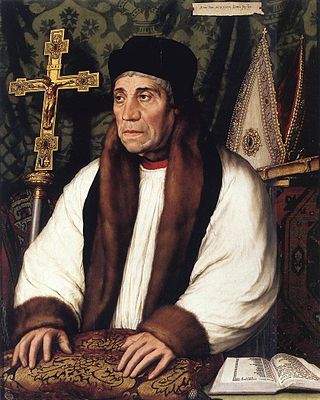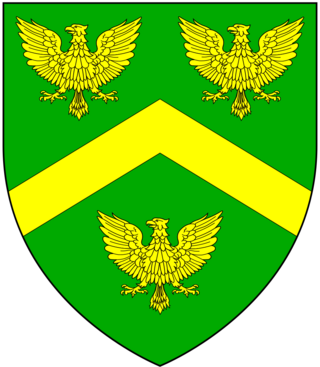Related Research Articles
Edmund de la Pole, 3rd Duke of Suffolk, 6th Earl of Suffolk, KG, Duke of Suffolk, was a son of John de la Pole, 2nd Duke of Suffolk and his wife Elizabeth of York.

William Warham was the Archbishop of Canterbury from 1503 to his death.
Thomas Grey, 1st Marquess of Dorset, 1st Earl of Huntingdon, 7th Baron Ferrers of Groby, was an English nobleman, courtier and the eldest son of Elizabeth Woodville and her first husband Sir John Grey of Groby. Her second marriage to King Edward IV made her Queen of England, thus elevating Grey's status at court and in the realm as the stepson of the King. Through his mother's assiduous endeavours, he made two materially advantageous marriages to wealthy heiresses, the King's niece Anne Holland and Cecily Bonville, 7th Baroness Harington. By the latter, he had 14 children.
James Beaton (1473–1539) was a Roman Catholic Scottish church leader, the uncle of David Cardinal Beaton and the Keeper of the Great Seal of Scotland.
John Taylor was Master of the Rolls of the Court of Chancery from 1527 to 1534, following a successful career as a priest and civil servant.
The Paston Letters is a collection of correspondence between members of the Paston family of Norfolk gentry and others connected with them in England between the years 1422 and 1509. The collection also includes state papers and other important documents.

John Yonge was an English ecclesiastic and diplomatist, who also served as Master of the Rolls from 1507 until his death.
Thomas Ruthall was an English churchman, administrator and diplomat. He was a leading councillor of Henry VIII of England.
Henry Deane was Archbishop of Canterbury from 1501 until his death.
Sir Stephen Jenyns was a wool merchant from Wolverhampton, Merchant of the Staple and Master Merchant Taylor who became Lord Mayor of London for the year of the coronation of King Henry VIII. An artistic, architectural and educational patron, he founded Wolverhampton Grammar School, and took a leading part in the rebuilding of the church of St. Andrew Undershaft in the City of London.

Sir John Fineux was an English judge and Chief Justice of the King's Bench.
Events from the 1500s in England.

Sir Richard Pole, KG was a supporter and first cousin of King Henry VII of England. He was created a Knight of the Garter and was married to Margaret Plantagenet, Countess of Salisbury, a member of the Plantagenet dynasty: a marriage which reinforced the Tudor alliance between the houses of Lancaster and York.
Sir Walter Hungerford of Farleigh fought for Henry VII at the Battle of Bosworth. He served on the Privy Council for both Henry VII and Henry VIII.

Sir Henry Wyatt KB (1460–1537) was an English nobleman, knight, courtier, and politician.
William Cosyn was priest, a JP for Somerset from 1506–1516, and Dean of Wells Cathedral from 1498–1525.
Sir John Shaa or Shaw was a London goldsmith. He served as engraver and later joint Master of the Mint, and as Sheriff and Lord Mayor of London. While Lord Mayor he entertained ambassadors from Scotland, and was among those who welcomed Catherine of Aragon to England. He is mentioned in a poem by William Dunbar.
John Paston I was an English country gentleman and landowner. He was the eldest son of the judge William Paston, Justice of the Common Pleas. After he succeeded his father in 1444, his life was marked by conflict occasioned by a power struggle in East Anglia between the dukes of Suffolk and Norfolk, and by his involvement in the affairs of his wife's kinsman, Sir John Fastolf. Between 1460–1466 he was Justice of the Peace for Norfolk, and was elected as a member of parliament in 1460 and again in 1461. A number of his letters survive among the Paston Letters, a rich source of historical information for the lives of the English gentry of the period.
Sir John Paston, was the second son of John Paston and Margaret Mautby. He succeeded his elder brother, Sir John Paston, in 1479. He fought at Barnet and Stoke with John de Vere, 13th Earl of Oxford, served as his deputy when Oxford was appointed Lord High Admiral of England, and was a member of the Earl's council. A number of his letters survive among the Paston Letters, a rich source of historical information about the lives of the English gentry of the period.
Sir Henry Heydon was the son of John Heydon of Baconsthorpe, Norfolk, 'the well-known opponent of the Paston family'. He married Anne Boleyn, the daughter of Sir Geoffrey Boleyn, great-grandfather of Henry VIII's queen Anne Boleyn.
References
- Government Titles during Tudor Times by Lara E. Eakins, retrieved December 2005
Attribution
 This article incorporates text from a publication now in the public domain : "Barons, William". Dictionary of National Biography . London: Smith, Elder & Co. 1885–1900.
This article incorporates text from a publication now in the public domain : "Barons, William". Dictionary of National Biography . London: Smith, Elder & Co. 1885–1900.